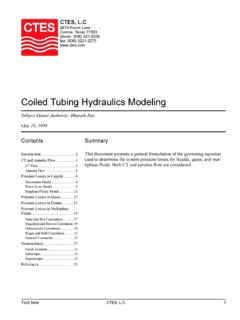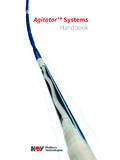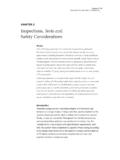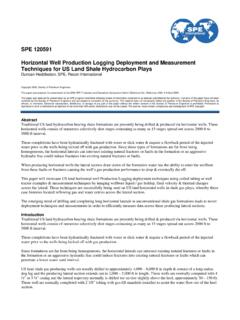Transcription of Basic Tubing Forces Model (TFM) Calculation
1 Tech NoteCTES, , Pozos LaneConroe, Texas 77303phone: (936) 521-2200fax: (936) Tubing Forces Model (TFM) CalculationSubject Matter Authority: Ken Newman, Kenneth Bhalla, & Albert McSpaddenOctober 2003 SummaryThe purpose of this document is to describe how Orpheus calculates Tubing Forces . These calculations are needed to determine the stresses in Coiled Tubing (CT) to ensure the safe working stresses are not being exceeded. They also are needed to predict the behavior of the CT in a highly deviated well, to determine if the planned job can be done, or to determine if the job being executed is proceeding as is a Tubing Forces Model (TFM) written specifically for Coiled Tubing (CT). The Basic TFM Calculation is performed by calculating the Forces along the length of a CT string at a specific depth in a well, as the string is being either run into the hole (RIH) or being pulled out of the hole (POOH).
2 This Calculation is performed beginning at the downhole end of the CT string and calculating the Forces on each segment of the string, pro-gressing up the string to the ..2 Theoretical versus Effective force ..5 Real force versus Weight ..8 Capstan or Belt Effect ..9 Sinusoidal Buckling Load ..9 Helical Buckling Load ..10 Lockup ..10 Effect of Curvature on Helical Buckling Load ..11 Residual Bend ..11 Stress Calculations ..12 Pressure Calculations ..12 Model Equations ..13 Basic Equation ..13 Effect of Fluid Flow ..13 Helical Buckling Load ..14 Wall Contact Period and Length Change ..14 Calculation Well Well Example ..16 Curved Well Example ..18 Nomenclature ..20 References ..21 Basic Tubing Forces Model (TFM) CalculationTech NoteCTES, Basic TFM Calculation is performed by summing the Forces on each segment as discussed above. This is performed with the end of the CT string at a specified depth.
3 The Basic Calculation is explained by using a simple example in which a CT segment is located in a straight, inclined section of a well without fluids or pressures, shown in Figure 1. As is dis-cussed later, the length of the segment could vary from a few feet to the entire length of the well depending on variations in well geometry and CT vector triangle in Figure 1 shows how a weight WS can be broken into two component Forces . FA is the force component in the axial direction (along the axis of the hole). FN is the force component in the normal direc-tion (normal or perpendicular to the axis of the hole). The equations for each of these components are:EQ 1EQ 2 FIGURE 1CT segment in a straight, inclined section of a wellFRFNFAWS CT SegmentHole WallFF cosSAWF= sinSNWF= Basic Tubing Forces Model (TFM) CalculationTech NoteCTES, friction force is calculated by multiplying the normal weight compo-nent by the friction coefficient.
4 EQ 3 The real axial force is found by summing the weight component in the axial direction, FA, with the friction caused by the normal component of the weight, FN. Note that the axial component of the weight causes FR to be in tension, which is defined as a positive force . However, the sign of the fric-tion force depends on the direction of motion. When RIH the friction causes a compressive (negative) force to be added to FR. When POOH the friction causes a tensile (positive) Forces to be added to 4 This is the Basic Calculation for one segment of the CT. Summing the results from a series of segments up a CT string yields the axial force on the CT in the well along it s length. This force versus length profile is cal-culated by Orpheus when the run at depth function is Calculation for tripping the CT string in and out of the hole simply repeats the run at depth TFM Calculation above for many specified depths, stepping the CT string into and out of the well.
5 The amount of data calculated during tripping is more than can be easily displayed. Thus, only the Forces at surface, commonly known as the Weight , are displayed when the trip in and out function is used in Orpheus. Each of these values is the result of a TFM Calculation along the entire length of the string in the Basic TFM can be adapted to account for rotation of CT in the hole during either tripping (to achieve greater reach) or drilling (as a by-product of down-hole motors). In order for a segment of CT to be rotated, the fric-tional resistance opposing the rotational motion, FRF, must be offset. Torque is the moment quantity which measures the ability of a force to rotate an object or oppose its rotation; it is equal to the force multiplied by the moment arm. So, TF, the torque associated with the opposing friction, would be the frictional force multiplied by the outer radius of the 5 The incremental torque associated with frictional contact between CT and casing surfaces must be calculated for each segment and summed up the length of the CT string in exactly the same manner as real axial force , FR, is =FARFFF =RFFrFT= Basic Tubing Forces Model (TFM) CalculationTech NoteCTES, the friction force acts in the direction opposite of motion, a simple analysis of the velocity vectors of the CT during tripping or drilling pro-vides a direct way to distribute some or all of the normal wall contact force between FF and FRF.
6 If the axial velocity of the CT is VA and the equivalent linear velocity of rotation is VR, then the resultant velocity VCT is the vector sum of VA and VR, as shown in Figure actual friction force will be in the direction opposite of VCT. Based on the velocity vector angle between VCT and VA, denoted by , the axial and rotational components of friction resistance can be 6If the CT string is continuously rotated while tripping into and out of the hole, then any initial static friction may be ignored. In this case, the oppos-ing torque due to friction is cumulative for all segments up to the top. How-ever, in the case of conventional CT drilling, the CT string itself is initially static. In this case, any torque caused by the down-hole motor is damped out by the torque associated with the drag of each CT segment. Since this is essentially a statics problem, a worst case solution is attained by apply-ing the entire friction force to both axial and rotational 2CT segment moving axially and rotationally sinNRFFF= cosNFFF= Basic Tubing Forces Model (TFM) CalculationTech NoteCTES, Con-ceptsThe above description of a Basic TFM only took into consideration mass and friction, and ignored the more complex issues of internal and external pressure, helical buckling, etc.
7 In this section the more difficult concepts are versus Effective ForceThere is often confusion about the difference between the real axial force (FR) and the effective force (FE), sometimes called the fictitious force . Suri Suryanarayana of Mobil has clarified this situation. This clarification is documented below using a simple example. Imagine a closed ended pipe suspended in a well as shown below:Let us consider only the lower section of this pipe from some point A downward. The variables used in this discussion are defined in the nomen-clature at the end of this axial force components acting below point A are:1. weight of the pipe acting downward = WS X2. upward force on the end of the pipe due to the external pressure =PoBAo3. downward force on the end of the pipe due to the internal pressure =PiBAiSumming these Forces to obtain the real axial force at A yields:EQ 7 FIGURE 3 Closed ended pipe suspended in a wellPo oPi iAxBooBiiBSRAPAPXWF += Basic Tubing Forces Model (TFM) CalculationTech NoteCTES, and PoB can be calculated as follows:EQ 8EQ 9 Defining the buoyant weight per foot as:EQ 10 Substituting Eq 8, Eq 9, and Eq 10 into Eq 7 and arranging terms yields:EQ 11 Another force , the effective force is now defined as:EQ 12 Note that this is a definition, not a real physical force .
8 The effective force is the real force without the effects of pressure included. This force turns out to be much more convenient to work with for several reasons. Note that the effective force at point A can now be written by combining Eq 11 and Eq 12 as:EQ 13 This is a much simpler equation to work with in a Tubing Forces Model than Eq 11. Also, as shown in the Tech Note The Effective force , the buck-ling characteristics of a pipe depend upon the effective force , not the real force . The physical significance is that buoyancy, which is independent of depth, affects buckling; however, pressure, which is dependent on depth, does not affect buckling. The only significant quantities that depend upon the real force are the stresses and strains. Thus, the Orpheus Tubing Forces Model works in effective force . The effective force is converted to real force only for stress calculations and output question that is often asked: Does the bottom hole pressure or the well head pressure try to force the CT out of the hole?
9 The same question can be asked another way: When pushing pipe in against pressure, Does the well-head pressure multiplied by the cross sectional area force need to be snubbed against or does the pressure at the bottom end of the pipe need to be snubbed against?iiAiBXPP +=ooAoBXPP +=ooiiSBAAWW +=ooAiiABRAPAPXWF +=ooAiiAREAPAPFF+ =XWFBE= Basic Tubing Forces Model (TFM) CalculationTech NoteCTES, answer this question assume point A in the above analysis is at the sur-face. The real force in Eq 7 is a function of the bottom of the pipe. How-ever, the real force in Eq 11 is a function of the pressure at the top of the pipe! When the buoyant weight is being used to calculate the weight of the pipe, as is usually the case, the wellhead pressure should be used to calcu-late the snubbing , since the TFM Calculation is performed segmentally from the bottom of the CT to the surface, a boundary condition or starting condi-tion is required at the bottom of the CT.
10 Consider Figure 3:1. If the end of the CT is closed, the real force FR(x=0) =PiBAi-PoBAo. From the definition of the effective force , FE(x=0) =FR(x=0) -PiBAi+PoBAo. Substituting for the real force yields, FE (x=0) = If the end of the CT is open, the real force FR(x=0) =PoB(Ai-Ao). Now from the definition of the effective force and the fact that PoB=PiB for an open tube gives, FE(x=0) = Tubing Forces Model (TFM) CalculationTech NoteCTES, force versus Weight The real force is calculated by rewriting Eq 12 to be:EQ 14 Consider the diagram shown in Figure real force just below the stripper can be calculated using Eq 14. Recall that it is this real force that must be used for stress calculations. The strip-per causes the effective force to change such that the effective force above the stripper is reduced by the amount of the wellhead pressure times the cross sectional area, plus or minus the stripper friction depending upon the direction of movement.






